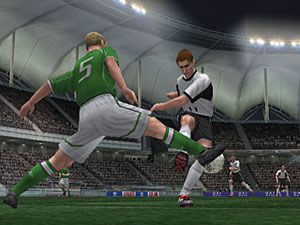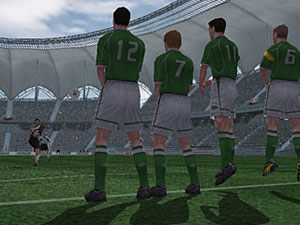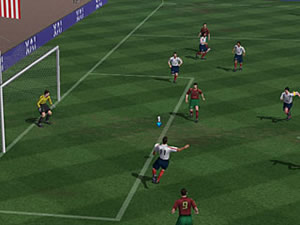You say football, I say futbol.
Once, when I was playing soccer with my friends, this guy named Vu kicked the ball so hard that it hit another guy in the face and knocked the brackets off his teeth, which became embedded in the ball itself. I was very impressed.
I am also very impressed with Konami’s Winning Eleven 6. Apparently
the most popular soccer series everywhere other than the United States, WE
6 proves that there is good taste elsewhere in the world.
However,
the fact that the game lacks any official licensing is disappointing. While
I don’t intensely follow International soccer (I only know I hate Renaldo and
Rivaldo), I know I’d be disappointed if I popped a basketball game into my PS2
only to find that the Sacramento Kings’ players had names like Frank Webber
and Andre Divac, or that the San Antonio Spurs had been completely left out
(as Manchester United has been from WE 6).
But in spite of lacking a trademark (literally) that every soccer fan is accustomed
to, WE 6 manages to even the score with interesting modes, terrific gameplay
and good graphics.
The modes include Match Mode, League Mode, Cup Mode, Master League Mode, Training
Mode and Edit Mode. Match, League and Cup are what you might expect, Master
League Mode is a watered-down version of other games’ Franchise Mode, and Training
Mode contains some pleasant surprises.
Training Mode actually contains three distinct modes, two of which are interesting and helpful. The third and least interesting is the actual Training Mode itself. Here you gain control of a player immediately before he is set to do the move or maneuver you are supposed to be learning. If you are able to execute the move correctly, you get to move on to the next lesson. Once you have completed the last lesson, you move onto the first, and the cycle begins anew.
Confused? I was too. In fact, the standard Training Mode is one of the most
confusing modes I’ve ever played in any sports game ever. The way you take control
of the player immediately before he’s meant to do the move, the huge block of
text that inadequately explains what you’re about to do and the bizarre way
you actually initiate the move combines to form a fairly useless exercise.
Fortunately, there are two more Training options, and they’re much better.
Free Training mimics an actual soccer practice, letting you practice all the
moves and maneuvers in the game and dividing up your team for playable scrimmages.
The Umbro Pro Training Center presents a series of mini-games all directed at
fine-tuning your soccer skills. From perfectly placing your shots on goal to
maintaining possession of the ball as close to your opponent’s net as you can
get for as long as possible, these drills entertain and prepare you for the
regular game.
The gameplay itself is remarkably good. Dribbling is essentially accomplished
by pressing a direction on the D-pad. If you quickly press a new direction,
your player will execute an effective cut/juke in that direction as soon as
he has control of the ball. The effect is the most realistic ball handling I’ve
ever experienced. Every tap of the D-pad is interpreted and expressed by the
game in a completely convincing, realistic fashion. As a result, learning is
easy as the better you play, the more and more realistic your players begin
to look.
 The
The
moves list is impressive, too. Everything from lob-passes to one-twos to the
ability to stop on a dime is well-implemented. However, I haven’t quite gotten
the hang of analog passing (pressing the right analog stick in the desired direction
to make a pass), and I don’t think it’s my fault. This means of passing is extremely
pressure sensitive, and the degree of accuracy and precision is a little difficult
with analog control. However, you can always pass with the X and Square buttons.
Setting ball trajectory isn’t handled very well. For example, when attempting
to place centering kicks (lob-style kicks meant to come down right in front
of or near the goal), the game tells you that by holding up or down on the control
pad you can manipulate the trajectory of the ball. Indeed, when holding down,
the ball skips along the ground as though it had been kicked on its upper half.
But when holding up, the ball flies with the same trajectory as if you had not
been pressing the D-pad at all, as opposed to really lobbing into the air. What’s
lacking here is the ability to visualize (as is done in the FIFA games)
how your shot/kick will behave before you begin your kick.
WE 6 looks good, mainly due to the astonishing animations. For example,
when a guy gets fouled, you can guess the severity of the penalty by the way
in which the fouled player falls. All dribbling animations are top-notch, and
are so because there is never any static posture or period at which the player
isn’t moving at all. The animations are seamlessly blended together for a shockingly
authentic look.
Aurally, WE 6 is pretty plain. While it’s nice that you can manipulate
the chants and reactions of the crowd, sound simply doesn’t play a huge role.
The dry broadcasters and whistles are the prime noises and neither is very interesting.
The stupid euro-techno that plays every time a goal is scored is annoying just
for its ubiquity.
But you’re not playing this game for its sound. Konami’s Winning Eleven
6 offers some of the most realistic and engaging gameplay of any soccer
game on the market, not to mention some surprising and entertaining Training
Modes. The lack of licensing, clear instructions during the tutorials and a
few play issues spoil some of WE 6′s game, but it still competes nicely
with the FIFA kingpin.

-
Great controls
-
Smooth animations
-
Interesting training modes
-
Which could use better instruction
-
Some unintuitive play mechanics







